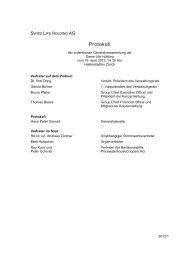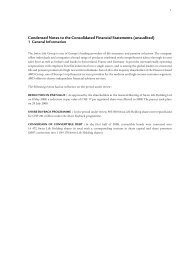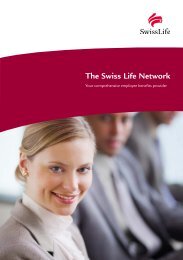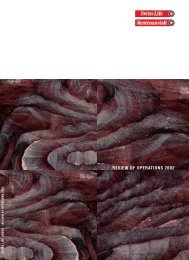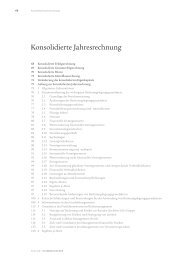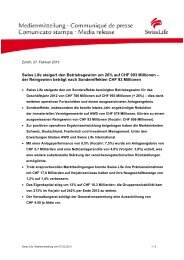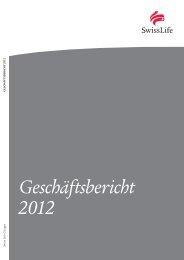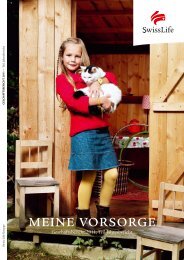Annual Report 2012 - Swiss Life
Annual Report 2012 - Swiss Life
Annual Report 2012 - Swiss Life
You also want an ePaper? Increase the reach of your titles
YUMPU automatically turns print PDFs into web optimized ePapers that Google loves.
130 Consolidated Financial Statements<br />
between the proceeds (net of transaction costs) and the redemption value is recognised in the income<br />
statement over the period of the borrowings.<br />
Based on the terms and conditions, such as repayment provisions and contractual interest payments,<br />
hybrid instruments are considered as financial liabilities.<br />
Debt instruments with embedded conversion options to a fixed number of shares of the Group are<br />
separated into a debt and an equity component. The difference between the proceeds and fair value<br />
of the debt at issuance is recorded in equity. The fair value of the debt at issuance is determined using<br />
a market interest rate for similar instruments with no conversion rights. The Group does not recognise<br />
any change in the value of these options in subsequent reporting periods.<br />
Borrowing costs presented in the consolidated statement of income relate to the interest expense on<br />
the financial liabilities classified as borrowings whilst interest expense presented in the consolidated<br />
statement of income relates to interest expense on bank deposits, insurance and investment contract<br />
deposits and repurchase agreements.<br />
Other Financial Liabilities<br />
For deposits with fixed and guaranteed terms the amortised cost basis is used. Initial recognition is<br />
at the proceeds received, net of transaction costs incurred. Subsequently, they are stated at amortised<br />
cost using the effective interest method. Any difference between the proceeds (net of transaction<br />
costs) and the redemption value is recognised in the income statement over the period of the deposits.<br />
For repurchase agreements, initial recognition is at the amount of cash received, net of transaction<br />
costs incurred. Subsequently, the difference between the amount of cash initially received and the<br />
amount of cash exchanged upon maturity is amortised over the life of the agreement using the effective<br />
interest method.<br />
2.20 Employee benefits<br />
Post-employment benefits<br />
The <strong>Swiss</strong> <strong>Life</strong> Group provides post-employment benefits under two types of arrangement: defined<br />
benefit plans and defined contribution plans.<br />
The assets of these plans are generally held separately from the Group’s general assets in trusteeadministered<br />
funds. Defined benefit plan contributions are based upon regulatory requirements<br />
and/or plan terms. The Group’s defined benefit obligations and the related service costs are determined<br />
at each balance sheet date by a qualified actuary, using the Projected Unit Credit Method.<br />
The amount recognised in the balance sheet represents the present value of the defined benefit obligations,<br />
reduced by the fair value of plan assets and adjusted for unrecognised actuarial gains and<br />
losses and unrecognised past ser vice costs. The recognition of a resulting asset is limited to the total<br />
of any cumulative unrecognised net actuarial losses and past service costs and the present value of<br />
any future refunds from the plans or reductions in future contributions to the plans.<br />
Unrecognised actuarial gains and losses which exceed 10% of the greater of the present value of the<br />
defined benefit obligations and the fair value of plan assets at the end of the previous reporting period<br />
are recognised in profit or loss over the expected average remaining working lives of the employees<br />
participating in the plans.<br />
<strong>Swiss</strong> <strong>Life</strong> – <strong>Annual</strong> <strong>Report</strong> <strong>2012</strong>



